The Relationships between PM2.5 and Meteorological Factors in China: Seasonal and Regional Variations
Abstract
:1. Introduction
2. Materials and Methods
2.1. Study Area and Period
2.2. Data Collection
2.3. Data Preprocessing
2.4. Methodology
3. Results
3.1. Spatiotemporal Variation of PM2.5 Concentration
3.2. Regional Variation of the Correlation Relationship
3.2.1. Correlation Analysis at the City Scale
3.2.2. Correlation Analysis at the Regional Scale
3.3. Seasonal Variation of the Correlation Relationships
3.4. Multivariate Linear Regression Results
4. Discussion
5. Conclusions
- (a)
- Spatially, the correlations between PM2.5 concentration and meteorological factors would vary with regions. The evidence is that RH is positively correlated with PM2.5 concentration in north China, but negatively correlated with PM2.5 in south China and other areas. The positive correlation between TEM and PM2.5 is weaker in north China than other areas. WS is negatively correlated with PM2.5 in almost every region, expect for Hainan Island. PS has a strong positive correlation with PM2.5 in northeast China and central China, but the correlation is weak in other places. The type of aerosol, the terrain, and the local climate can all be inducers of the regional variations.
- (b)
- Seasonally, there exists seasonal variations of the correlation between PM2.5 concentration and meteorological factors. The positive correlation between RH and PM2.5 is stronger in winter and spring; TEM is positively correlated with PM2.5 in winter and is negatively correlated with PM2.5 in autumn; and WS has the strongest correlation with PM2.5 in winter; and the correlation between PM2.5 and PS is the strongest in autumn. All anthropogenic and natural differences, such as the use of heating systems in the north China winter, and weather variations in the four seasons, may bring about seasonal variations.
Supplementary Materials
Acknowledgments
Author Contributions
Conflicts of Interest
References
- Luo, J.; Du, P.; Samat, A.; Xia, J.; Che, M.; Xue, Z. Spatiotemporal Pattern of PM2.5 Concentrations in Mainland China and Analysis of Its Influencing Factors using Geographically Weighted Regression. Sci. Rep. 2017, 7, 40607. [Google Scholar] [CrossRef] [PubMed]
- Li, G.; Fang, C.; Wang, S.; Sun, S. The effect of economic growth, urbanization, and industrialization on fine particulate matter (PM2.5) concentrations in China. Environ. Sci. Technol. 2016, 50, 11452–11459. [Google Scholar] [CrossRef] [PubMed]
- World Health Organization; UNAIDS. Air Quality Guidelines: Global Update 2005; World Health Organization: Geneva, Switzerland, 2006. [Google Scholar]
- Zhang, F.; Cheng, H.R.; Wang, Z.W.; Lv, X.P.; Zhu, Z.M.; Zhang, G.; Wang, X.M. Fine particles (PM2.5) at a CAWNET background site in Central China: Chemical compositions, seasonal variations and regional pollution events. Atmos. Environ. 2014, 86, 193–202. [Google Scholar] [CrossRef]
- Wu, J.; Zhu, J.; Li, W.; Xu, D.; Liu, J. Estimation of the PM2.5 health effects in China during 2000–2011. Environ. Sci. Pollut. Res. 2017, 24, 10695–10707. [Google Scholar] [CrossRef] [PubMed]
- Guo, Y.; Zeng, H.; Zheng, R.; Li, S.; Barnett, A.G.; Zhang, S.; Zou, X.; Huxley, R.; Chen, W.; Williams, G. The association between lung cancer incidence and ambient air pollution in China: A spatiotemporal analysis. Environ. Res. 2016, 144, 60–65. [Google Scholar] [CrossRef] [PubMed]
- Lu, X.; Lin, C.; Li, Y.; Yao, T.; Fung, J.C.; Lau, A.K. Assessment of health burden caused by particulate matter in southern China using high-resolution satellite observation. Environ. Int. 2017, 98, 160–170. [Google Scholar] [CrossRef] [PubMed]
- Zhao, C.; Tie, X.; Lin, Y. A possible positive feedback of reduction of precipitation and increase in aerosols over eastern central China. Geophys. Res. Lett. 2006, 33. [Google Scholar] [CrossRef]
- Cao, J.J.; Shen, Z.X.; Chow, J.C.; Watson, J.G.; Lee, S.C.; Tie, X.X.; Ho, K.F.; Wang, G.H.; Han, Y.M. Winter and summer PM2.5 chemical compositions in fourteen Chinese cities. J. Air Waste Manag. 2012, 62, 1214–1226. [Google Scholar] [CrossRef]
- Liu, J.; Rühland, K.M.; Chen, J.; Xu, Y.; Chen, S.; Chen, Q.; Huang, W.; Xu, Q.; Chen, F.; Smol, J.P. Aerosol-weakened summer monsoons decrease lake fertilization on the Chinese Loess Plateau. Nat. Clim. Chang. 2017, 7, 190–194. [Google Scholar] [CrossRef]
- Xie, Y.; Dai, H.; Dong, H.; Hanaoka, T.; Masui, T. Economic impacts from PM2.5 pollution-related health effects in China: A provincial-Level analysis. Environ. Sci. Technol. 2016, 50, 4836–4843. [Google Scholar] [CrossRef] [PubMed]
- Chen, T.; Guo, J.; Li, Z.; Zhao, C.; Liu, H.; Cribb, M.; Wang, F.; He, J. A CloudSat perspective on the cloud climatology and its association with aerosol perturbation in the vertical over East China. J. Atmos. Sci. 2016, 73, 3599–3616. [Google Scholar] [CrossRef]
- Wall, C.; Zipser, E.; Liu, C. An Investigation of the Aerosol Indirect Effect on Convective Intensity Using Satellite Observations. J. Atmos. Sci. 2014, 71, 430–447. [Google Scholar] [CrossRef]
- Lee, S.-S.; Guo, J.P.; Li, Z. Delaying precipitation by air pollution over Pearl River Delta. Part 2: Model simulations. J. Geophys. Res. Atmos. 2016, 121, 11739–11760. [Google Scholar] [CrossRef]
- Guo, J.; Li, Z.; Miao, Y.; Li, J.; Liu, H.; Xu, H.; Cribb, M.; Zhai, P. Declining frequency of summertime local-scale precipitation over eastern China from 1970–2010 and its potential link to aerosols. Geophys. Res. Lett. 2017, 44, 5700–5708. [Google Scholar] [CrossRef]
- Dai, W.; Gao, J.; Cao, G.; Ouyang, F. Chemical composition and source identification of PM2.5 in the suburb of Shenzhen, China. Atmos. Res. 2013, 122, 391–400. [Google Scholar] [CrossRef]
- Lai, S.; Zhao, Y.; Ding, A.; Zhang, Y.; Song, T.; Zheng, J.; Song, T.; Zheng, J.; Lee, S.; Zhong, L. Characterization of PM2.5 and the major chemical components during a 1-year campaign in rural Guangzhou, southern China. Atmos. Res. 2016, 167, 208–215. [Google Scholar] [CrossRef]
- Cai, W.; Li, K.; Liao, H.; Wang, H.; Wu, L. Weather conditions conducive to Beijing severe haze more frequent under climate change. Nat. Clim. Chang. 2017, 7, 257–262. [Google Scholar] [CrossRef]
- Liu, Y.; Zhao, N.; Vanos, J.K.; Cao, G. Effects of synoptic weather on ground-level PM2.5 concentrations in the United States. Atmos. Environ. 2017, 148, 297–305. [Google Scholar] [CrossRef]
- Zhang, H.; Wang, Y.; Park, T.W.; Deng, Y. Quantifying the relationship between extreme air pollution events and extreme weather events. Atmos. Res. 2017, 188, 64–79. [Google Scholar] [CrossRef]
- Chang, W.; Zhan, J. The association of weather patterns with haze episodes: Recognition by PM2.5 oriented circulation classification applied in Xiamen, Southeastern China. Atmos. Res. 2017, 197, 425–436. [Google Scholar] [CrossRef]
- Jones, A.M.; Harrison, R.M.; Baker, J. The wind speed dependence of the concentrations of airborne particulate matter and NOx. Atmos. Environ. 2010, 44, 1682–1690. [Google Scholar] [CrossRef]
- Chen, T.; He, J.; Lu, X.; She, J.; Guan, Z. Spatial and Temporal Variations of PM2.5 and Its Relation to Meteorological Factors in the Urban Area of Nanjing, China. Int. J. Environ. Res. Public Health 2016, 13, 921. [Google Scholar] [CrossRef] [PubMed]
- Li, Y.; Chen, Q.; Zhao, H.; Wang, L.; Tao, R. Variations in PM10, PM2.5 and PM1.0 in an urban area of the Sichuan Basin and their relation to meteorological factors. Atmosphere 2015, 6, 150–163. [Google Scholar] [CrossRef]
- Huang, F.; Li, X.; Wang, C.; Xu, Q.; Wang, W.; Luo, Y.; Tao, L.; Gao, Q.; Guo, J.; Chen, S.; et al. PM2.5 spatiotemporal variations and the relationship with meteorological factors during 2013–2014 in Beijing, China. PLoS ONE 2015, 10, e0141642. [Google Scholar] [CrossRef] [PubMed]
- Xu, J.; Yan, F.; Xie, Y.; Wang, F.; Wu, J.; Fu, Q. Impact of meteorological conditions on a nine-day particulate matter pollution event observed in December 2013, Shanghai, China. Particuology 2015, 20, 69–79. [Google Scholar] [CrossRef]
- Zhang, H.; Wang, Y.; Hu, J.; Ying, Q.; Hu, X.M. Relationships between meteorological parameters and criteria air pollutants in three megacities in China. Environ. Res. 2015, 140, 242–254. [Google Scholar] [CrossRef] [PubMed]
- Chen, Z.; Cai, J.; Gao, B.; Xu, B.; Dai, S.; He, B.; Xie, X. Detecting the causality influence of individual meteorological factors on local PM2.5 concentration in the Jing-Jin-Ji region. Sci. Rep. 2017, 7, 40735. [Google Scholar] [CrossRef] [PubMed]
- Li, J.; Wang, G.; Wang, X.; Cao, J.; Sun, T.; Cheng, C.; Meng, J.; Hu, T.; Liu, S. Abundance, composition and source of atmospheric PM2.5 at a remote site in the Tibetan Plateau, China. Tellus B Chem. Phys. Meteorol. 2013, 65, 20281. [Google Scholar]
- Tai, A.P.; Mickley, L.J.; Jacob, D.J. Correlations between fine particulate matter, PM2.5 and meteorological variables in the United States: Implications for the sensitivity of PM2.5 to climate change. Atmos. Environ. 2010, 44, 3976–3984. [Google Scholar] [CrossRef]
- Tran, H.N.; Mölders, N. Investigations on meteorological conditions for elevated PM2.5 in Fairbanks, Alaska. Atmos. Res. 2011, 99, 39–49. [Google Scholar] [CrossRef]
- Wang, Y.; Ying, Q.; Hu, J.; Zhang, H. Spatial and temporal variations of six criteria air pollutants in 31 provincial capital cities in China during 2013–2014. Environ. Int. 2014, 73, 413–422. [Google Scholar] [CrossRef] [PubMed]
- Daly, C.; Gibson, W.P.; Taylor, G.H.; Johnson, G.L.; Pasteris, P. A knowledge-based approach to the statistical mapping of climate. Clim. Res. 2002, 22, 99–113. [Google Scholar] [CrossRef]
- Krivoruchko, K. Empirical Bayesian Kriging; ESRI: Redlands, CA, USA, 2012; Available online: www.esri.com/NEWS/ARCUSER/1012/files/ebk.pdf (accessed on 30 November 2017).
- Zhang, H.; Wang, Z.; Zhang, W. Exploring spatiotemporal patterns of PM2.5 in China based on ground-level observations for 190 cities. Environ. Pollut. 2016, 216, 559–567. [Google Scholar] [CrossRef] [PubMed]
- Yan, S.; Cao, H.; Chen, Y.; Wu, C.; Hong, T.; Fan, H. Spatial and temporal characteristics of air quality and air pollutants in 2013 in Beijing. Environ. Sci. Pollut. Res. 2016, 23, 13996–14007. [Google Scholar] [CrossRef] [PubMed]
- Kassomenos, P.A.; Vardoulakis, S.; Chaloulakou, A.; Paschalidou, A.K.; Grivas, G.; Borge, R.; Lumbreras, J. Study of PM10 and PM2.5 levels in three European cities: Analysis of intra and inter urban variations. Atmos. Environ. 2014, 87, 153–163. [Google Scholar] [CrossRef]
- Barnaba, F.; Gobbi, G.P. Aerosol seasonal variability over the Mediterranean region and relative impact of maritime, continental and Saharan dust particles over the basin from MODIS data in the year 2001. Atmos. Chem. Phys. 2004, 4, 2367–2391. [Google Scholar] [CrossRef]
- Ma, Z.; Hu, X.; Huang, L.; Bi, J.; Liu, Y. Estimating ground-level PM2.5 in China using satellite remote sensing. Environ. Sci. Technol. 2014, 48, 7436–7444. [Google Scholar] [CrossRef] [PubMed]
- Geng, G.; Zhang, Q.; Martin, R.V.; van Donkelaar, A.; Huo, H.; Che, H.; Lin, J.; He, K. Estimating long-term PM2.5 concentrations in China using satellite-based aerosol optical depth and a chemical transport model. Remote Sens. Environ. 2015, 166, 262–270. [Google Scholar] [CrossRef]
- Li, T.; Shen, H.; Zeng, C.; Yuan, Q.; Zhang, L. Point-surface fusion of station measurements and satellite observations for mapping PM2.5 distribution in China: Methods and assessment. Atmos. Environ. 2017, 152, 477–489. [Google Scholar] [CrossRef]
- Li, T.; Shen, H.; Yuan, Q.; Zhang, X.; Zhang, L. Estimating ground-level PM2.5 by fusing satellite and station observations: A geo-intelligent deep learning approach. Geophys. Res. Lett. 2017, 44. [Google Scholar] [CrossRef]
- Lu, D.; Xu, J.; Yang, D.; Zhao, J. Spatio-temporal variation and influence factors of PM2.5 concentrations in China from 1998 to 2014. Atmos. Pollut. Res. 2017, 8, 1151–1159. [Google Scholar] [CrossRef]
- Wu, P.; Ding, Y.; Liu, Y. Atmospheric circulation and dynamic mechanism for persistent haze events in the Beijing-Tianjin-Hebei region. Adv. Atmos. Sci. 2017, 34, 429–440. [Google Scholar] [CrossRef]
- Guo, J.; Miao, Y.; Zhang, Y.; Liu, H.; Li, Z.; Zhang, W.; He, J.; Lou, M.; Yan, Y.; Bian, L.; et al. The climatology of planetary boundary layer height in China derived from radiosonde and reanalysis data. Atmos. Chem. Phys. 2016, 16, 13309–13319. [Google Scholar] [CrossRef]
- Zheng, M.; Salmon, L.G.; Schauer, J.J.; Zeng, L.; Kiang, C.S.; Zhang, Y.; Cass, G.R. Seasonal trends in PM2.5 source contributions in Beijing, China. Atmos. Environ. 2005, 39, 3967–3976. [Google Scholar] [CrossRef]
- Dan, M.; Zhuang, G.; Li, X.; Tao, H.; Zhuang, Y. The characteristics of carbonaceous species and their sources in PM2.5 in Beijing. Atmos. Environ. 2004, 38, 3443–3452. [Google Scholar] [CrossRef]
- Wang, B.; Wu, R.; Lau, K.M. Interannual variability of the Asian summer monsoon: Contrasts between the Indian and the western North Pacific–East Asian monsoons. J. Clim. 2001, 14, 4073–4090. [Google Scholar] [CrossRef]
- Hu, D.; Qiao, L.; Chen, J.; Ye, X.; Yang, X.; Cheng, T.; Fang, W. Hygroscopicity of inorganic aerosols: Size and relative humidity effects on the growth factor. Aerosol. Air Qual. Res. 2010, 10, 255–264. [Google Scholar] [CrossRef]
- Ye, X.; Chen, J. Haze and hygroscopic growth. Chin. J. Nat. 2013, 35, 337–341. [Google Scholar]
- Dawson, J.P.; Adams, P.J.; Pandis, S.N. Sensitivity of PM2.5 to climate in the Eastern US: A modeling case study. Atmos. Chem. Phys. 2007, 7, 4295–4309. [Google Scholar] [CrossRef]
- Guo, J.P.; Zhang, X.Y.; Che, H.Z.; Gong, S.L.; An, X.Q.; Cao, C.X.; Guang, J.; Zhang, H.; Wang, Y.Q.; Zhang, X.C.; et al. Correlation between PM Concentrations and Aerosol Optical Depth in Eastern China. Atmos. Environ. 2009, 43, 5876–5886. [Google Scholar] [CrossRef]
- Wu, Y.R.; Guo, J.P.; Zhang, X.Y.; Tian, X.; Zhang, J.H.; Wang, Y.Q.; Duan, J.; Li, X.W. Synergy of satellite and ground based observations in estimation of particulate matter in eastern China. Sci. Total Environ. 2012, 433, 20–30. [Google Scholar] [CrossRef] [PubMed]
- Chu, Y.; Liu, Y.; Li, X.; Liu, Z.; Lu, H.; Lu, Y.; Mao, Z.; Chen, X.; Li, N.; Ren, M.; et al. A Review on Predicting Ground PM2.5 Concentration Using Satellite Aerosol Optical Depth. Atmosphere 2016, 7, 129. [Google Scholar] [CrossRef]
- Ma, X.; Wang, J.; Yu, F.; Jia, H.; Hu, Y. Can MODIS AOD be employed to derive PM2.5 in Beijing-Tianjin-Hebei over China? Atmos. Res. 2016, 181, 250–256. [Google Scholar] [CrossRef]
- Fang, X.; Zou, B.; Liu, X.; Sternberg, T.; Zhai, L. Satellite-based ground PM2.5 estimation using timely structure adaptive modeling. Remote Sens. Environ. 2016, 186, 152–163. [Google Scholar] [CrossRef]
- Hu, X.; Waller, L.A.; Al-Hamdan, M.Z.; Crosson, W.L.; Estes, M.G.; Estes, S.M.; Quattrochi, D.A.; Sarnat, J.A.; Liu, Y. Estimating ground-level PM2.5 concentrations in the southeastern US using geographically weighted regression. Environ. Res. 2013, 121, 1–10. [Google Scholar] [CrossRef] [PubMed]

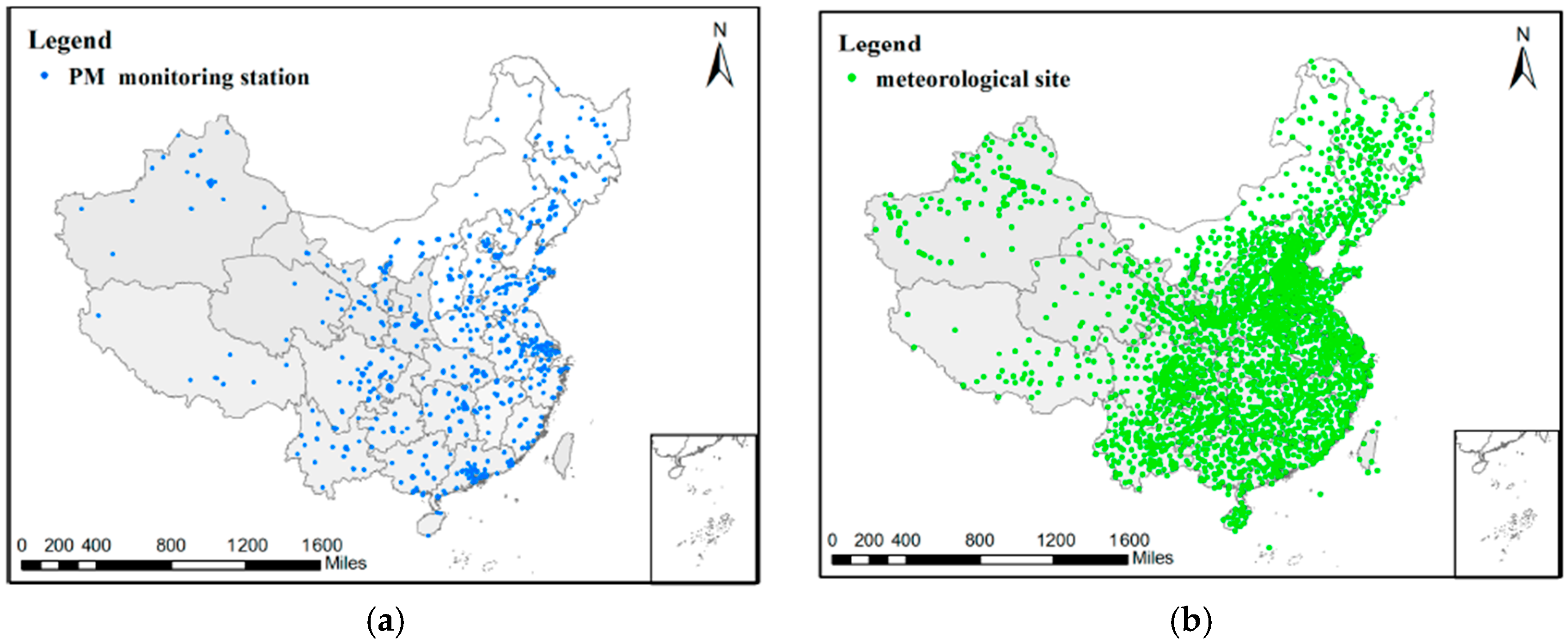
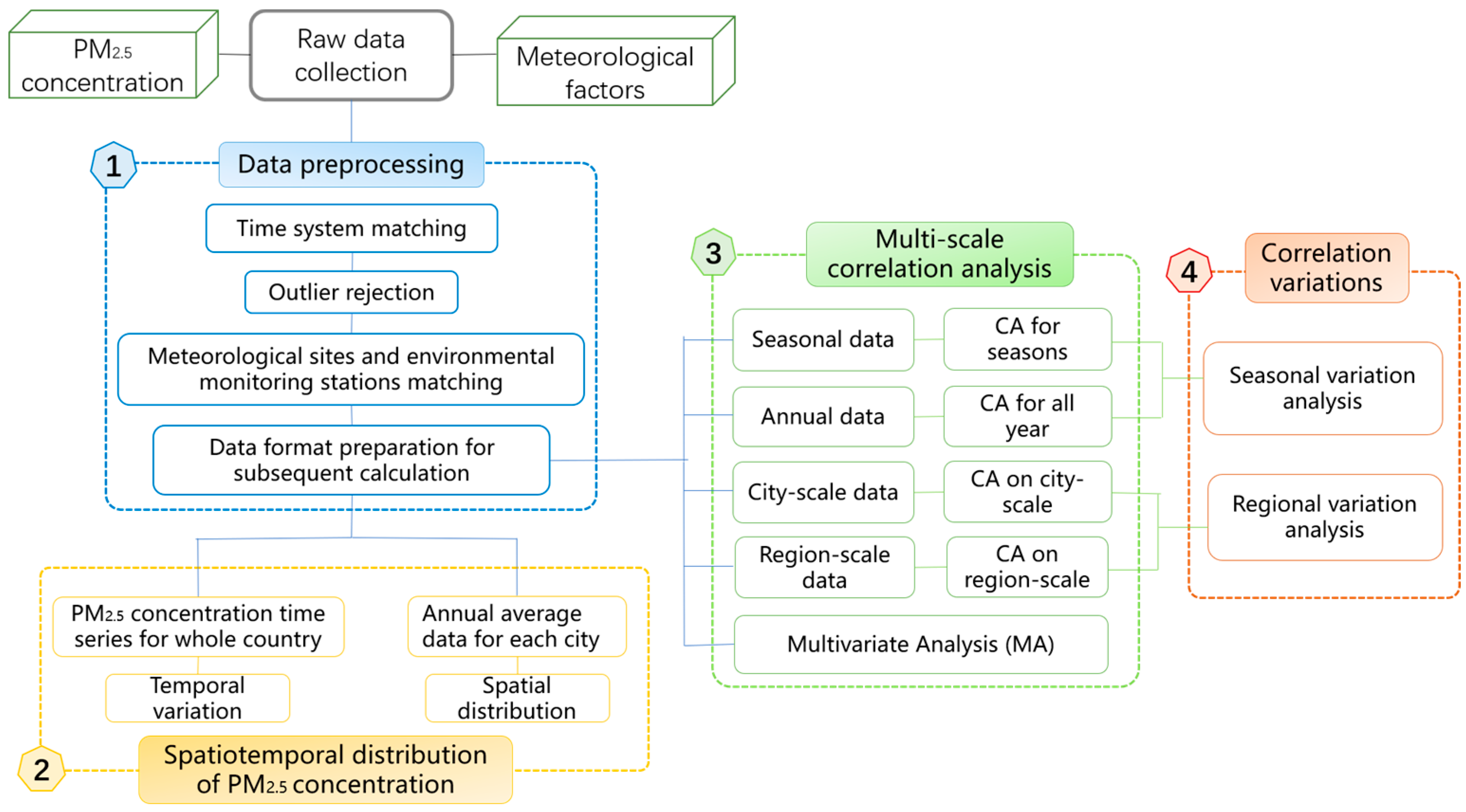
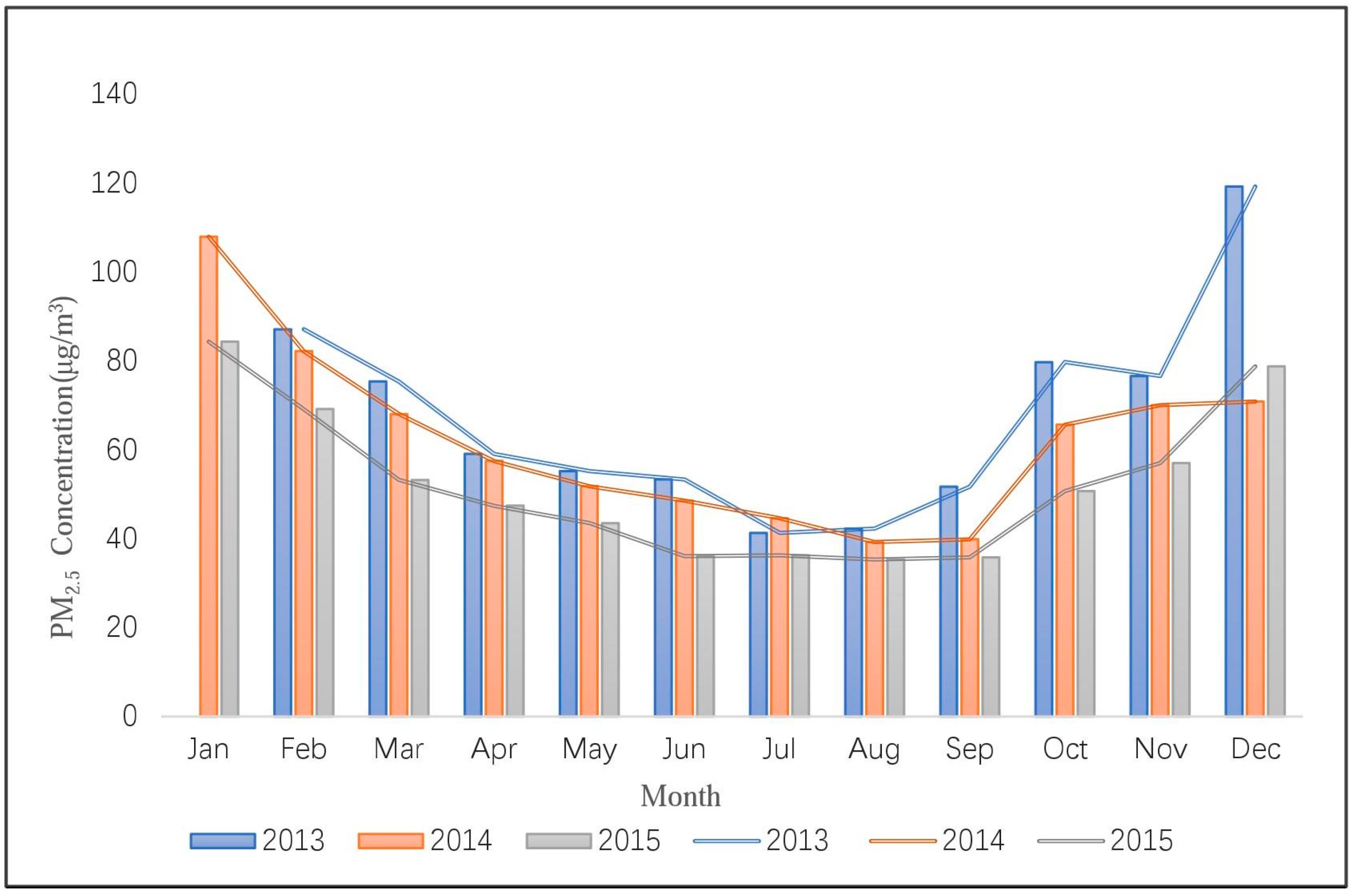

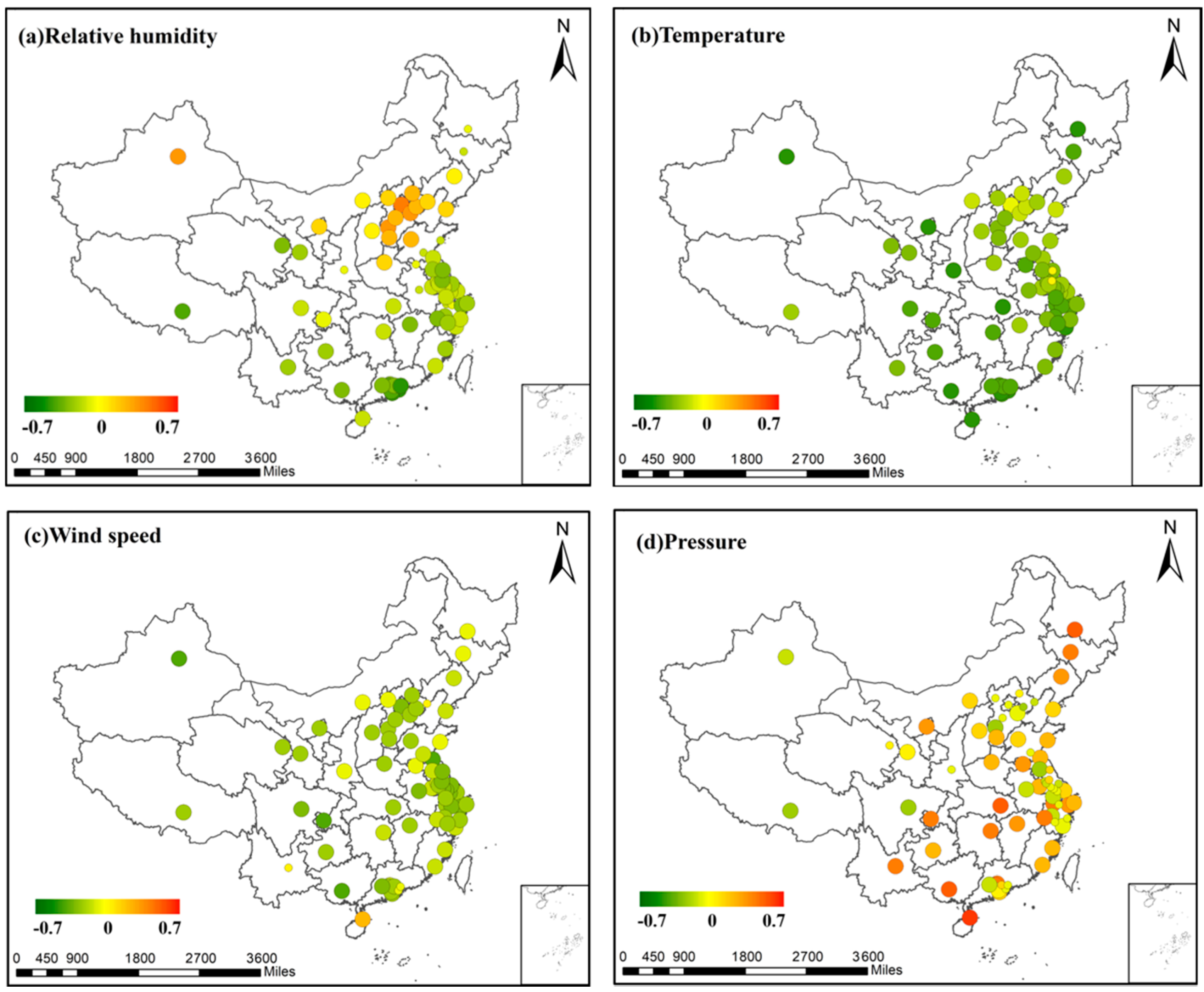

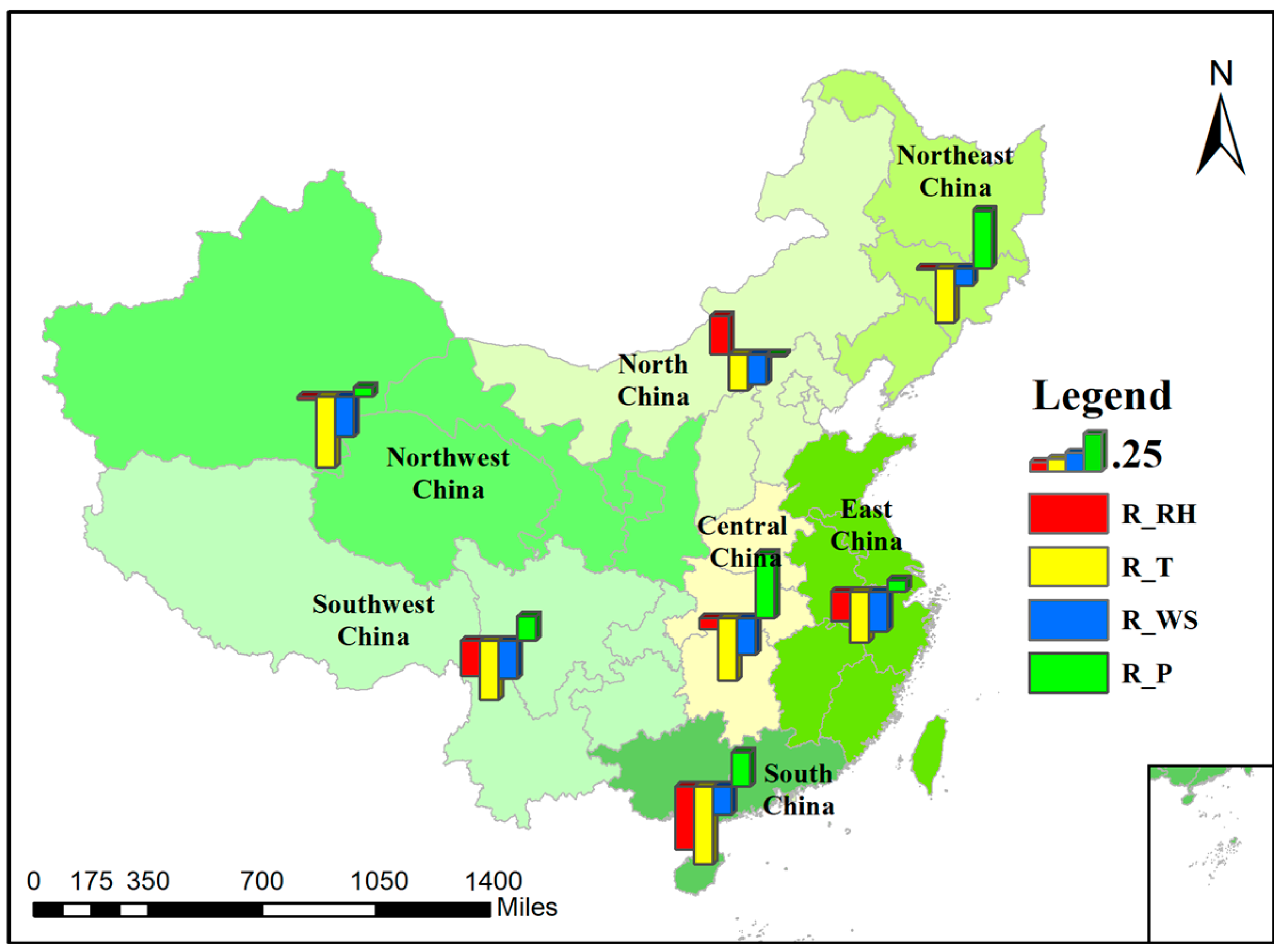



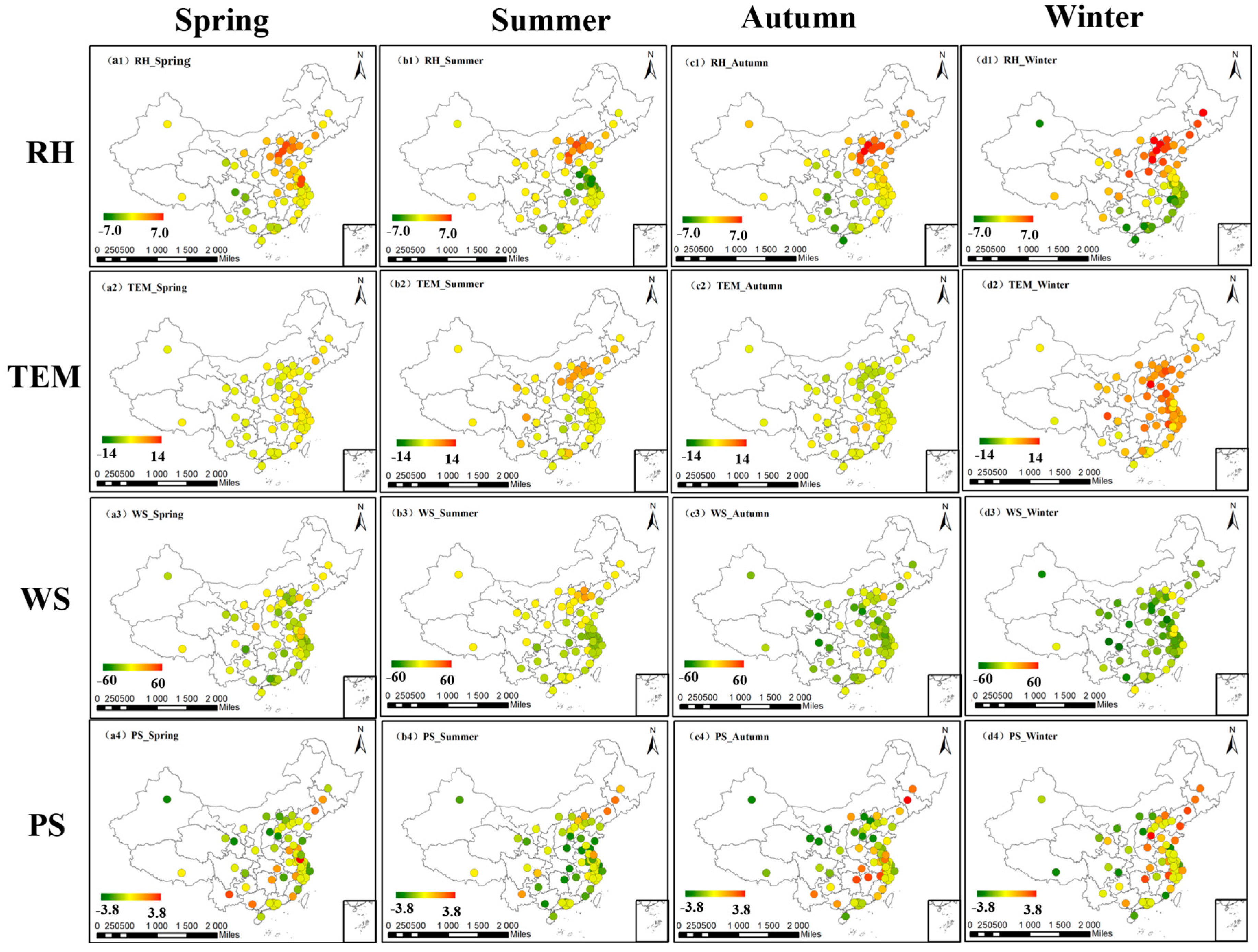
| Region | City | Correlation Coefficient (r) | Significance p-Value | ||||||
|---|---|---|---|---|---|---|---|---|---|
| r-RH | r-TEM | r-WS | r-PS | P-RH | P-TEM | P-WS | P-PS | ||
| North China | Beijing | 0.484 | −0.072 | −0.376 | −0.004 | 0.0000 | 0.0009 | 0.0000 | 0.2176 |
| Tianjin | 0.307 | −0.106 | −0.206 | −0.075 | 0.0000 | 0.0000 | 0.0000 | 0.0405 | |
| Shijiazhuang | 0.331 | −0.368 | −0.291 | −0.228 | 0.0000 | 0.0000 | 0.0000 | 0.0170 | |
| Tangshan | 0.294 | −0.149 | −0.202 | −0.204 | 0.0000 | 0.0000 | 0.0000 | 0.3530 | |
| Qinhuangdao | 0.161 | −0.202 | 0.022 | −0.190 | 0.0000 | 0.0000 | 0.4443 | 0.1493 | |
| Baoding | 0.272 | −0.380 | −0.212 | −0.067 | 0.0000 | 0.0000 | 0.0000 | 0.9763 | |
| Zhangjiakou | 0.166 | −0.300 | −0.030 | −0.030 | 0.0000 | 0.0000 | 0.0074 | 0.8171 | |
| Chengde | 0.238 | −0.137 | −0.221 | 0.034 | 0.0000 | 0.0002 | 0.0000 | 0.0696 | |
| Xingtai | 0.274 | −0.370 | −0.266 | 0.243 | 0.0000 | 0.0000 | 0.0000 | 0.0000 | |
| Taiyuan | 0.062 | −0.287 | −0.248 | 0.192 | 0.0104 | 0.0000 | 0.0000 | 0.0433 | |
| Huhehaote | 0.091 | −0.174 | −0.088 | 0.153 | 0.0481 | 0.0000 | 0.0133 | 0.0000 | |
| South China | Guangzhou | −0.376 | −0.427 | −0.179 | 0.444 | 0.0000 | 0.0000 | 0.0037 | 0.0000 |
| Shenzhen | −0.504 | −0.531 | −0.031 | −0.061 | 0.0000 | 0.0000 | 0.3108 | 0.0637 | |
| Zhuhai | −0.502 | −0.596 | −0.233 | 0.119 | 0.0000 | 0.0000 | 0.0000 | 0.0174 | |
| Foshan | −0.423 | −0.440 | −0.233 | 0.471 | 0.0000 | 0.0000 | 0.0000 | 0.0000 | |
| Zhongshan | −0.445 | −0.510 | −0.274 | 0.073 | 0.0000 | 0.0000 | 0.0000 | 0.0019 | |
| Dongguan | −0.375 | −0.450 | −0.273 | 0.153 | 0.0000 | 0.0000 | 0.0000 | 0.2288 | |
| Huizhou | −0.585 | −0.453 | −0.019 | −0.027 | 0.0000 | 0.0000 | 0.7030 | 0.5015 | |
| Zhaoqing | −0.322 | −0.453 | −0.356 | −0.188 | 0.0000 | 0.0000 | 0.0000 | 0.0005 | |
| Nanning | −0.324 | −0.534 | −0.435 | 0.592 | 0.0000 | 0.0000 | 0.0000 | 0.0000 | |
| Haikou | −0.157 | −0.590 | 0.220 | 0.606 | 0.0000 | 0.0000 | 0.0045 | 0.0000 | |
| Region (Type Number) | Major Factors (|r| > 0.3) | Minor Factors (0.3 > |r| > 0.2) |
|---|---|---|
| North China (1) | / | RH, TEM |
| South China (2) | TEM, RH | PS |
| Central China (3) | PS, TEM | WS |
| Northeast China (3) | PS, TEM | \ |
| Southwest China (4) | TEM | WS |
| Northwest China (4) | TEM | WS |
| East China (4) | TEM | WS |
| Spring | Summer | ||||||||
| Region | RH | TEM | WS | PS | Region | RH | TEM | WS | PS |
| Central China | 0.04 | −0.01 | −0.28 | 0.04 | Central China | 0.06 | −0.13 | −0.32 | 0.00 |
| North China | 0.48 | −0.03 | −0.28 | −0.16 | North China | 0.30 | 0.21 | 0.03 | −0.22 |
| South China | −0.18 | −0.48 | −0.33 | 0.16 | South China | −0.27 | 0.26 | −0.28 | −0.26 |
| Southwest China | −0.22 | −0.02 | −0.17 | 0.09 | Southwest China | −0.21 | 0.20 | −0.18 | −0.07 |
| Northwest China | −0.01 | −0.20 | −0.14 | −0.08 | Northwest China | −0.10 | 0.24 | −0.02 | −0.20 |
| Northeast China | −0.05 | 0.03 | −0.15 | 0.14 | Northeast China | −0.08 | 0.26 | −0.02 | 0.14 |
| East China | −0.12 | 0.16 | −0.30 | −0.10 | East China | −0.08 | −0.05 | −0.32 | 0.05 |
| Average | −0.01 | −0.08 | −0.24 | 0.01 | Average | −0.05 | 0.14 | −0.16 | −0.08 |
| Autumn | Winter | ||||||||
| Region | RH | TEM | WS | PS | Region | RH | TEM | WS | PS |
| Central China | −0.23 | −0.01 | −0.10 | 0.14 | Central China | −0.03 | 0.26 | −0.33 | −0.05 |
| North China | 0.34 | −0.07 | −0.30 | −0.15 | North China | 0.54 | 0.27 | −0.43 | −0.19 |
| South China | −0.44 | −0.35 | −0.10 | 0.16 | South China | −0.48 | −0.05 | −0.37 | 0.03 |
| Southwest China | −0.30 | −0.15 | −0.34 | 0.07 | Southwest China | 0.08 | −0.01 | −0.38 | 0.07 |
| Northwest China | −0.10 | −0.29 | −0.28 | −0.14 | Northwest China | 0.13 | 0.00 | −0.34 | −0.07 |
| Northeast China | 0.13 | −0.25 | −0.16 | 0.25 | Northeast China | 0.52 | 0.09 | −0.54 | 0.14 |
| East China | −0.17 | −0.35 | −0.33 | 0.15 | East China | −0.20 | 0.27 | −0.36 | −0.12 |
| Average | −0.11 | −0.21 | −0.23 | 0.07 | Average | 0.08 | 0.12 | −0.39 | −0.03 |
© 2017 by the authors. Licensee MDPI, Basel, Switzerland. This article is an open access article distributed under the terms and conditions of the Creative Commons Attribution (CC BY) license (http://creativecommons.org/licenses/by/4.0/).
Share and Cite
Yang, Q.; Yuan, Q.; Li, T.; Shen, H.; Zhang, L. The Relationships between PM2.5 and Meteorological Factors in China: Seasonal and Regional Variations. Int. J. Environ. Res. Public Health 2017, 14, 1510. https://doi.org/10.3390/ijerph14121510
Yang Q, Yuan Q, Li T, Shen H, Zhang L. The Relationships between PM2.5 and Meteorological Factors in China: Seasonal and Regional Variations. International Journal of Environmental Research and Public Health. 2017; 14(12):1510. https://doi.org/10.3390/ijerph14121510
Chicago/Turabian StyleYang, Qianqian, Qiangqiang Yuan, Tongwen Li, Huanfeng Shen, and Liangpei Zhang. 2017. "The Relationships between PM2.5 and Meteorological Factors in China: Seasonal and Regional Variations" International Journal of Environmental Research and Public Health 14, no. 12: 1510. https://doi.org/10.3390/ijerph14121510





